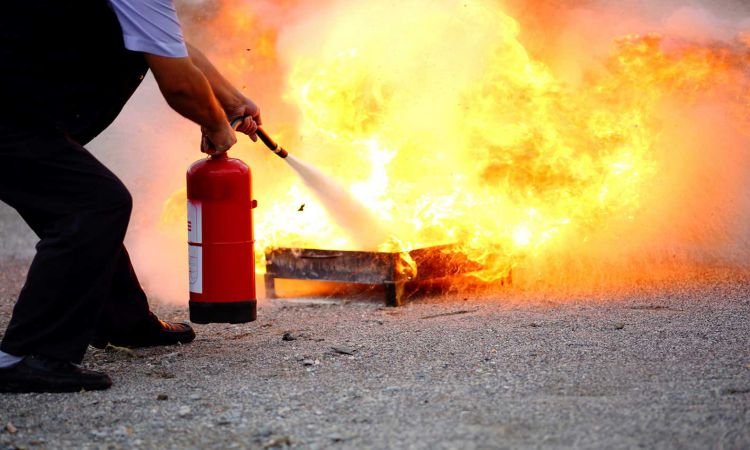 Every firefighter must know the different fire and fire attack classes to respond effectively. For example, many fires are caused by an external heat source, such as a kitchen or vehicle fire. Other fires may be caused by an electrical or chemical emergency and require a different response.
Every firefighter must know the different fire and fire attack classes to respond effectively. For example, many fires are caused by an external heat source, such as a kitchen or vehicle fire. Other fires may be caused by an electrical or chemical emergency and require a different response.
And then, there is the explosive gas emergency, which requires a different strategy than other fires. The following details will define these six emergency categories and provide examples of these situations through pictures and short descriptions.
6 Types of Classes
Class A
Ordinary Combustible Materials (examples: wood, paper, cloth, and most plastics) Any of these materials will burn quickly if exposed to flame. However, they have a lower flash point (the temperature at which the material will catch fire) than many other types of materials.
Class B
Flammable Liquids (examples: gasoline, kerosene, oil-based paint) These types of liquids have a flashpoint below 100o F. They are flammable but will not burn as well as Class A materials.
Class C
Combustible Liquids (examples: vegetable oils, paraffin wax, used motor oil) These types of liquids have a flashpoint between 100o and 200o F. Since they have a lower flash point than Class B material and don’t burn as well as some Classes C materials, they require special precautions when handling them to prevent fires from starting.
Class D
Flammable Solids (examples: wood treated with preservatives, cotton, sawdust) Class D solid materials have a flashpoint below 100o F and burn similarly to Class A materials.
Read more about ballistic barrier product.
Class E
Combustible Metals (examples: magnesium, sodium, potassium) These metals are very reactive and may ignite if exposed to heat or a flame. They will also react with water and produce hydrogen gas. Hydrogen gas can be explosive when mixed with air in the proper proportions.
Class F
Cooking Oils and Greases (examples: vegetable oil, used cooking oil, animal fats) Class F materials are combustible liquids with a flashpoint below 100o F. They can ignite very quickly when exposed to heat or a flame. Because of their characteristics, they require special handling and storage procedures when dealing with fires involving them.
Ways to Attack Fire
1. Gas
If you smell an odor of gas escaping from a fire, evacuate immediately. Gas fires are hazardous because the controlling agent, oxygen, can be released quickly. As a result, the fire can spread very quickly and could become uncontrollable if the gas has a concentration of over 50 parts per million.
2. Electricity
If you see electrical sparks coming from a fire, evacuate immediately. Electrical fires can spread very quickly and become uncontrollable. In addition, electrical fires caused extensive damage because of the intense heat. The arc flash suit is a vital piece of protective gear designed to safeguard electrical workers from the dangers of arc flash incidents, providing a crucial barrier against extreme heat and potential injuries.
3. Water
If you see water pouring from a fire, evacuate immediately. A water fire can burn through building materials, become uncontrollable, and cause extensive damage if not stopped quickly.
4. Heat
If you see an area where the fire is burning hotter than other areas, it may be spreading too quickly to be controlled at that location. It would help if you evacuated the area immediately with everyone safely to a place of safety.
5. Smoke
If you see smoke coming from a fire, it is already out of control, and you should evacuate immediately. Smoke is a sign that the fire burns with more intensity than what can be controlled. Air can become filled with toxic and flammable substances if the fire is hot enough to produce smoke.
6. Fuel Source
If you are at a vehicle fire, look for the source of the fire. The fuel source could be an electrical spark in the engine compartment, gasoline leaking from a gas tank rupture, or a fuel line leak. If you can locate the fuel source and stop it from igniting, the vehicle should not flash over and start another spot fire.
7. Extinguishers
Remember, to extinguish a fire, you must remove the heat source or oxygen from surrounding the fuel source. Three types of extinguishers can be used in Class A, and Class B fires water, dry chemicals, and carbon dioxide. Water is used on ordinary combustible materials like wood and paper.
8. Extinguishing Agents
Dry chemical extinguishers are similar to fire extinguishers but have different chemicals that can be used on Class B and Class C fires. Dry chemical extinguishers also have a more powerful, sustained nozzle, which can be used on Class D and Class E fires.
When you are in the midst of an emergency, it can be overwhelming to know what you face. The more knowledge and experience the Fire Watch Guards have the better prepared they will be to react quickly and effectively to stop and control the emergency. Fire crews’ safety is a top priority. If firefighters take advantage of what they have learned and act quickly to stop the fire, they can avoid serious injury and death.




